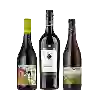
Winery Bergerie de FenouilletFenolheto Expression Mosaïque
This wine is a blend of 2 varietals which are the Cabernet-Sauvignon and the Mourvèdre.
This wine generally goes well with beef, veal or pasta.
Food and wine pairings with Fenolheto Expression Mosaïque
Pairings that work perfectly with Fenolheto Expression Mosaïque
Original food and wine pairings with Fenolheto Expression Mosaïque
The Fenolheto Expression Mosaïque of Winery Bergerie de Fenouillet matches generally quite well with dishes of beef, pasta or veal such as recipes of baked marrow bones, my lasagna bolognese (without béchamel sauce) or veal tagine with prunes.
Details and technical informations about Winery Bergerie de Fenouillet's Fenolheto Expression Mosaïque.
Discover the grape variety: Cabernet-Sauvignon
Cabernet-Sauvignon noir is a grape variety that originated in France (Bordeaux). It produces a variety of grape specially used for wine making. It is rare to find this grape to eat on our tables. This variety of grape is characterized by small bunches, and small grapes. Cabernet-Sauvignon noir can be found in many vineyards: South-West, Loire Valley, Languedoc & Roussillon, Cognac, Bordeaux, Armagnac, Rhone Valley, Provence & Corsica, Savoie & Bugey, Beaujolais.
Informations about the Winery Bergerie de Fenouillet
The Winery Bergerie de Fenouillet is one of of the world's great estates. It offers 40 wines for sale in the of Hérault to come and discover on site or to buy online.
The wine region of Hérault
The wine region of Hérault is located in the region of Pays d'Oc of Vin de Pays of France. Wineries and vineyards like the Domaine La Grange des Pères or the Domaine La Grange des Pères produce mainly wines red, white and pink. The most planted grape varieties in the region of Hérault are Merlot, Cabernet-Sauvignon and Chardonnay, they are then used in wines in blends or as a single variety. On the nose of Hérault often reveals types of flavors of minerality, yellow apple or passion fruit and sometimes also flavors of nutty, anise or stone fruit.
The wine region of Pays d'Oc
Pays d'Oc is the PGI for red, white and rosé wines that are produced over a wide area of the southern coast of France. The PGI catchment area corresponds roughly to the Languedoc-roussillon">Languedoc-Roussillon wine region, one of the largest wine regions in France. The area covers all wines that are not produced under the strict laws that govern AOC-level appellations in the regions: among them, Corbières, Minervois and the Languedoc appellation itself. The Pays d'Oc PGI is arguably the most important in France, producing the majority of the country's PGI wines.
The word of the wine: Collar
The upper, cylindrical part of the bottle. Sales of wine bottles are generally expressed in number of bottles.













